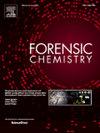发现混凝土中氯气暴露的选择性标记物
IF 2.6
3区 医学
Q2 CHEMISTRY, ANALYTICAL
引用次数: 0
摘要
氯气(Cl2)在现代战区仍被用作化学武器。在受到这种有毒化学物质的攻击后,由于其反应性和快速蒸发,验证其使用是具有挑战性的。此外,只发现了数量有限的与氯气使用有关的选择性标记。为了法医的目的,有必要将Cl2与其他含氯化学品区分开来。因此,本研究旨在利用气相色谱-质谱(GC-MS)和液相色谱-高分辨率串联质谱(LC-HRMS/MS)结合机器学习方法发现氯气暴露的选择性标记物。来自欧洲或中东的四种混凝土暴露在不同水平的二氧化氯以及一些常用的含氯化学品中。用各种溶剂提取后,对样品进行分析。在对32个氯代标记物进行GC-MS和146个标记物进行LC-HRMS/MS初步鉴定的基础上,建立了主成分分析(PCA)和线性判别分析(LDA)模型。暴露于漂白剂和氯气的混凝土样品之间的明显区别是显而易见的。对于法医分类,贝叶斯似然比(LR)模型显示误导证据率有限,最大似然比为0.038 ~ 93。氯丙酮、二氯丙酮、四氯苯酚和5-氯-8-喹啉酚标记物对氯气暴露具有选择性。用GC-MS /MS和LC-MS/MS与市售标准品进行了鉴别。总之,本研究证明了在混凝土中进行化学分析以区分不同氯化剂的可行性。本文章由计算机程序翻译,如有差异,请以英文原文为准。

Discovery of selective markers for chlorine gas exposure in concrete
Chlorine gas (Cl2) is still being used as a chemical weapon in modern war zones. After an attack with this toxic chemical, verifying its use is challenging due to its reactivity and rapid evaporation. Additionally, only a limited number of selective markers relating to the use of chlorine gas are found. For forensic purposes it is necessary to discriminate Cl2 from other chlorine containing chemicals. Therefore, the current study aims to use gas chromatography–mass spectrometry (GC–MS) and liquid chromatography-high resolution tandem mass spectrometry (LC-HRMS/MS) together with machine learning methods to discover selective markers for chlorine gas exposure. Four types of concrete originating from Europe or the Middle East were exposed to various levels of Cl2 as well as to some commonly used chlorine containing chemicals. After extraction with various solvents, the samples were analyzed. Based on the tentative identification of 32 chlorinated markers with GC–MS and 146 markers with LC-HRMS/MS, principal component analysis (PCA) and linear discriminant analysis (LDA) models were constructed. A clear distinction between concrete samples exposed to bleach and chlorine gas was apparent. For forensic classification, a Bayesian likelihood ratio (LR) model was applied that showed limited rates of misleading evidence and maximum LRs of 0.038 to 93. The markers chloroacetone, dichloroacetone, tetrachlorophenol, and 5-chloro-8-quinolinol were found to be selective for chlorine gas exposure. Their identity was verified by GC–MS/MS and LC-MS/MS in comparison with commercially available reference standards. In conclusion, this study demonstrates the feasibility of chemical profiling in concrete to differentiate among various chlorinating agents.
求助全文
通过发布文献求助,成功后即可免费获取论文全文。
去求助
来源期刊

Forensic Chemistry
CHEMISTRY, ANALYTICAL-
CiteScore
5.70
自引率
14.80%
发文量
65
审稿时长
46 days
期刊介绍:
Forensic Chemistry publishes high quality manuscripts focusing on the theory, research and application of any chemical science to forensic analysis. The scope of the journal includes fundamental advancements that result in a better understanding of the evidentiary significance derived from the physical and chemical analysis of materials. The scope of Forensic Chemistry will also include the application and or development of any molecular and atomic spectrochemical technique, electrochemical techniques, sensors, surface characterization techniques, mass spectrometry, nuclear magnetic resonance, chemometrics and statistics, and separation sciences (e.g. chromatography) that provide insight into the forensic analysis of materials. Evidential topics of interest to the journal include, but are not limited to, fingerprint analysis, drug analysis, ignitable liquid residue analysis, explosives detection and analysis, the characterization and comparison of trace evidence (glass, fibers, paints and polymers, tapes, soils and other materials), ink and paper analysis, gunshot residue analysis, synthetic pathways for drugs, toxicology and the analysis and chemistry associated with the components of fingermarks. The journal is particularly interested in receiving manuscripts that report advances in the forensic interpretation of chemical evidence. Technology Readiness Level: When submitting an article to Forensic Chemistry, all authors will be asked to self-assign a Technology Readiness Level (TRL) to their article. The purpose of the TRL system is to help readers understand the level of maturity of an idea or method, to help track the evolution of readiness of a given technique or method, and to help filter published articles by the expected ease of implementation in an operation setting within a crime lab.
 求助内容:
求助内容: 应助结果提醒方式:
应助结果提醒方式:


